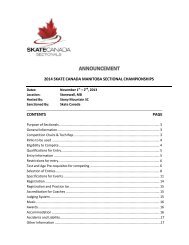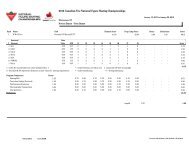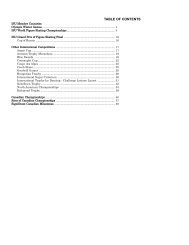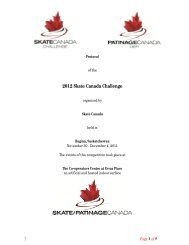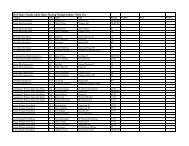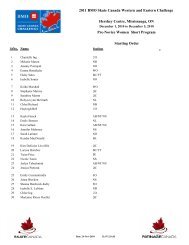LONG-TERM ATHLETE DEVELOPMENT - Skate Canada
LONG-TERM ATHLETE DEVELOPMENT - Skate Canada
LONG-TERM ATHLETE DEVELOPMENT - Skate Canada
Create successful ePaper yourself
Turn your PDF publications into a flip-book with our unique Google optimized e-Paper software.
3. Specialization<br />
Sports can be classified as either early or late<br />
specialization. Early specialization sports include artistic<br />
and acrobatic sports such as gymnastics, diving, and<br />
figure skating. These differ from late specialization sports<br />
in that very complex skills are learned before maturation<br />
since it becomes more difficult to fully master if<br />
taught after maturation. This means that fundamental<br />
movement and motor skills as well as basic sport skills<br />
must be learned and acquired at an early age in order to<br />
maximize athlete progression.<br />
Synchronized skating is a unique discipline as it is also<br />
considered a late specialization sport. Participants<br />
in Synchronized skating can compete at the highest<br />
level of competition once they have achieved more<br />
complex Synchronized skating skills that they may not<br />
have achieved prior to maturation. They can continue<br />
to develop and improve skills as adults if they have<br />
achieved very strong sport skills in the Learn to Train and<br />
Learn to Compete stages and even begin to specialize in<br />
synchronized skating after completing careers in singles,<br />
ice dance or pair skating.<br />
Disability sports are also late specialization sports and<br />
it is critically important that athletes with a disability<br />
be exposed to the full range of fundamentals before<br />
specializing in one sport.<br />
4. Developmental Age<br />
Developmental age refers to the degree of an individual’s<br />
physical, mental, cognitive and emotional maturity. <strong>Skate</strong><br />
<strong>Canada</strong>’s LTADM — though still tied to chronological age<br />
to a certain extent (due in large<br />
865 Sheord Road, Ottawa, Ontario K1J 1H9<br />
Phone 613.747.1007 I Toll Free 1.888.747.2372 I Fax 613.748.5718 I Toll Free Fax 1.877.211.2372<br />
8<br />
part by the age parameters established by the ISU)<br />
— emphasizes training based on developmental age,<br />
viewing this concept of biological age as paramount to<br />
the success of athletic and personal development.<br />
LTAD is based on maturation (growth and development), not chronological age. We all follow the same stages<br />
to maturity, but the timing, rate and magnitude of maturity of various qualities differs between individuals.<br />
LTAD requires the identification of early, late and average maturation to help design appropriate instruction,<br />
training and competition programs according to the readiness of the participant. In order to design a tailormade<br />
training program to the athlete at puberty, it becomes important to determine precisely the onset of the<br />
growth spurt and the peak height velocity curve (PHV).



